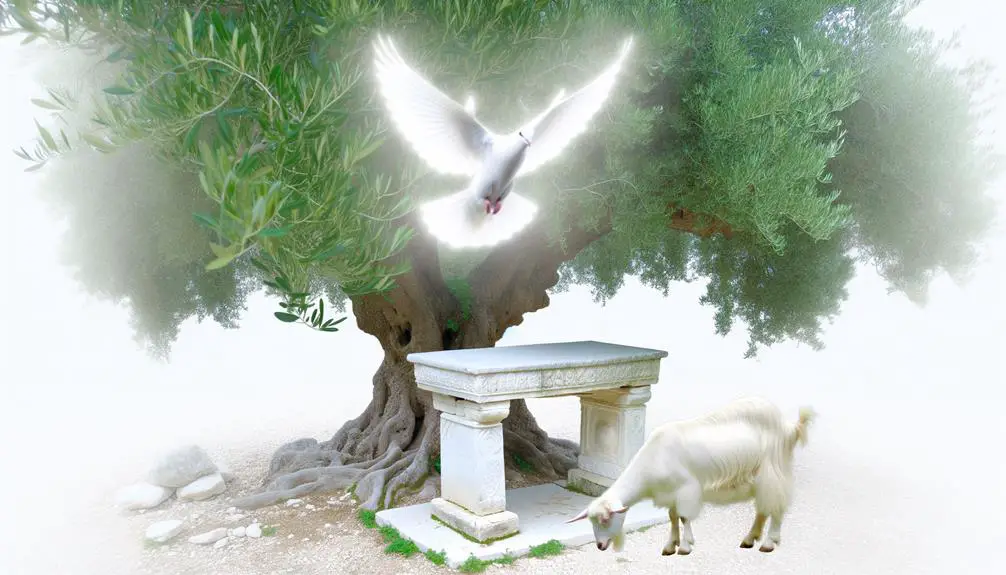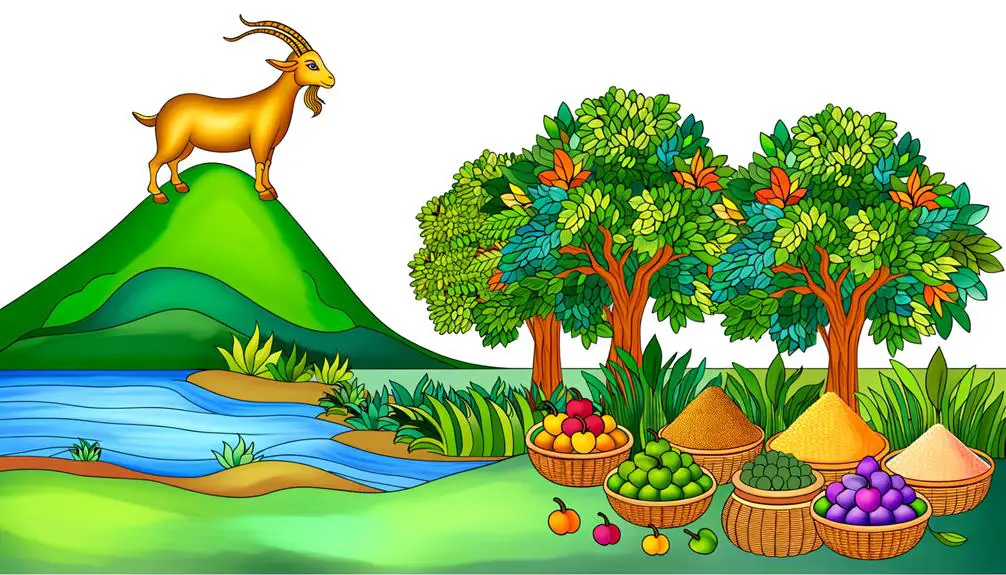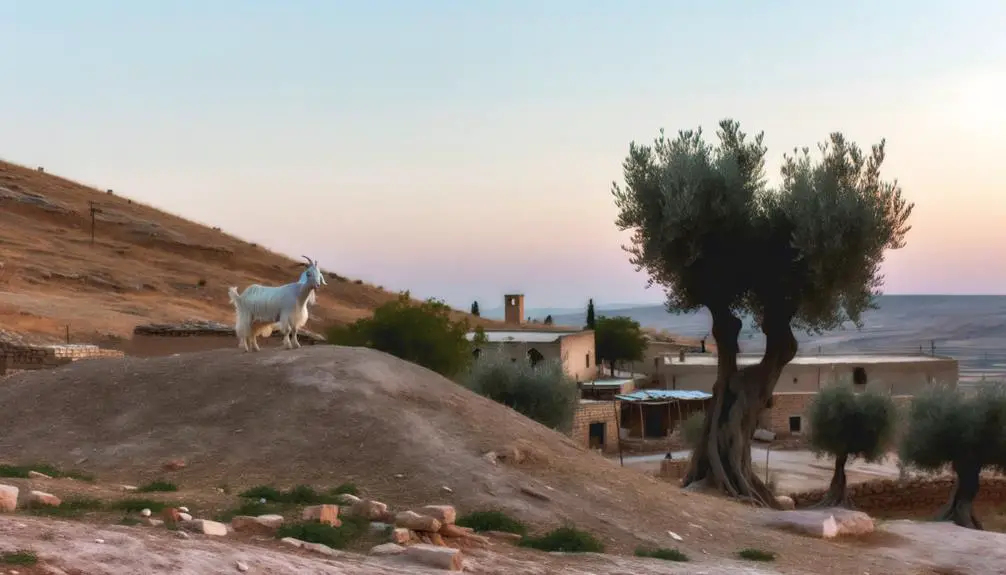In the Bible, goats symbolize sin and purity, revealing a deep paradox of judgement and redemption that invites further exploration.

What Does a Goat Represent in the Bible
In the heart of ancient rituals, you'll find the goat, a creature symbolizing both sin and purity within the biblical narrative. Consider the scapegoat ritual, an act of transferring the community's sins to a goat and sending it into the wilderness, a vivid portrayal of atonement and exile.
But the story doesn't end there. As you explore the layers of meaning behind the goat's symbolism, you'll uncover a complex tapestry of judgement, division, and even prosperity.
The question then becomes, how does this duality influence our understanding of biblical messages and their application in contemporary life? Let's journey into this intriguing paradox.
Key Takeaways
- Goats symbolize atonement and purification in biblical rites, notably through the Scapegoat Ritual during Yom Kippur.
- In biblical narratives, goats represent sin and impurity, contrasted with the purity symbolized by lambs.
- Goats are central to sacrificial offerings for sin, playing a crucial role in maintaining ceremonial cleanliness and expressing repentance.
- Beyond their role in sin atonement, goats also symbolize abundance, prosperity, and resilience in challenging environments.
The Scapegoat Ritual

Delving into the Scapegoat Ritual, one observes a profound mechanism of atonement and communal purification within ancient Israelite society. Rooted in the Levitical laws, this practice, particularly emphasized during Yom Kippur, the Day of Atonement, served as a cornerstone for the collective expiation of sins. You'll find that the ritual wasn't merely an act of transferring wrongdoings to an animal but a sophisticated expression of societal repentance and divine mercy.
The Scapegoat Ritual, as outlined in the Levitical laws, involved selecting two goats: one for the Lord and the other as the scapegoat. This dichotomy embodies a tangible representation of the Israelites' approach to sin and forgiveness. The first goat's sacrifice symbolized the seriousness with which they approached the notion of sin, acknowledging its presence and the necessity of its removal from their midst. The second goat, however, carried a different, equally weighty significance. The high priest would confess over it the community's sins, symbolically placing these transgressions upon it before sending it into the wilderness.
This act of sending away the scapegoat represented a physical removal of sin from the community, illustrating a collective yearning for purification and a fresh start. It's crucial to note that the wilderness, where the scapegoat was sent, wasn't merely a desolate space but a symbolically loaded one, often associated with chaos, danger, and moral ambiguity. Hence, the ritual encapsulated a profound understanding of human fallibility and divine grace, underpinning the ancient Israelite's yearning for reconciliation with their deity.
Sacrificial Symbolism

You'll find that goats hold a significant place in the sacrificial rituals of the Old Testament, symbolizing sins atonement and playing a critical role in Passover sacrifices.
These offerings weren't arbitrary but deeply embedded in the fabric of ancient religious practices, serving as a tangible means for the people to seek reconciliation with the divine.
The connection between goats and these rituals underscores their importance in understanding the complex tapestry of biblical symbolism and its implications for both ancient and contemporary interpretations.
Old Testament Offerings
In the Old Testament, goats often symbolized sin and were regularly used as sacrificial offerings to atone for the sins of the people. This practice was deeply embedded in Levitical regulations, which served as a meticulous framework for maintaining ceremonial cleanliness among the Israelites.
These regulations weren't arbitrary; rather, they were imbued with rich symbolic meaning, reflecting a profound understanding of sin's impact on communal life and the necessity of reconciliation with the divine. Through the act of offering goats, the community engaged in a tangible expression of repentance, acknowledging their transgressions and seeking purification.
This ritualistic use of goats underscores their significance beyond mere livestock, highlighting their role as essential conduits for spiritual cleansing and restoration within the ancient Hebrew religious landscape.
Sins Atonement Rituals
To understand the deep-seated symbolism within sins atonement rituals, it's essential to examine the intricate role sacrificial offerings played in ancient religious practices. Goats, in particular, held significant value in these rituals, symbolizing the removal and forgiveness of sins.
Aspect |
Description |
Impact on Modern Interpretations |
|---|---|---|
Ritualistic Origins |
Rooted in ancient traditions of expiation. |
Influences contemporary views on atonement. |
Symbolic Value |
Represented sin being transferred and eradicated. |
Shapes the metaphorical understanding of redemption. |
Sacrificial Role |
Essential for ceremonial purification. |
Informs modern perspectives on sacrifice and penance. |
This framework not only offers insights into the ritualistic origins but also sheds light on how these ancient practices influence modern interpretations of spiritual purification and redemption.
Passover Sacrifice Connection
Why is the Passover sacrifice, particularly the use of goats, so pivotal in understanding ancient and modern religious symbolism? The goat, in this context, isn't just an animal; it's a profound symbol embedded within Feast traditions. This act of sacrifice serves as a Redemption metaphor, illustrating the liberation from bondage and the transition from slavery to freedom.
- Goats in Passover symbolize purity and sacrifice.
- They embody the essence of atonement, crucial for the redemption narrative.
- Feast traditions often highlight the communal sharing of the goat, reinforcing unity.
- The goat as a Redemption metaphor bridges ancient rituals with contemporary faith practices.
This connection underlines the depth of sacrificial symbolism, where a simple act resonates with layers of spiritual and communal significance, encapsulating the essence of redemption and renewal.
Judgement and Division

Within biblical narratives, goats often symbolize judgement and division, marking a clear distinction between the righteous and the unrighteous. This imagery resonates deeply with the ancient societal roles and courtroom settings, where the fate of individuals was determined with utmost solemnity. In such contexts, goats serve as a potent symbol, embodying the outcomes of divine judgement and the separation inherent in moral and spiritual adjudication.
The use of goats to represent these themes is not arbitrary. Their portrayal in scripture aligns with broader narratives of redemption and condemnation. This duality mirrors societal expectations and the roles individuals play within the moral framework of their communities. Just as a judge in a courtroom determines the fate of individuals based on law and testimony, so too does the biblical narrative use goats to illustrate the ultimate judgement that separates individuals based on their spiritual state.
Symbolic Element |
Interpretation |
|---|---|
Goat as Sacrifice |
Represents the atonement of sins and the necessary separation from unrighteousness. |
Division of Goats and Sheep |
Illustrates the final judgement, separating the righteous from the unrighteous based on deeds and faith. |
Goats in Parables |
Often used to challenge societal norms and expectations, questioning the roles individuals assume in the moral order. |
Through these elements, goats embody not just the concept of judgement but also the complex interplay of societal roles and divine justice. This multifaceted symbolism invites a deeper contemplation of one's own spiritual state and societal position, reflecting the intricate relationship between divine judgement and human morality.
Wealth and Prosperity

In biblical times, goats weren't merely livestock; they symbolized abundance and marked a household's wealth.
You'll find that their presence indicated not just material prosperity but also divine favor and societal status.
Analyzing their role illuminates how prosperity was understood and valued in ancient cultures, offering a nuanced view of biblical narratives.
Symbol of Abundance
Exploring biblical narratives reveals that goats often symbolize abundance, signifying wealth and prosperity in various contexts. Their role in festive celebrations and agricultural significance highlights their importance in ancient societies. Goats weren't only valued for their meat and milk but also for their skins and hair, contributing to the economy and daily life.
- *Festive celebrations* often featured goats as central elements, underscoring their value.
- Their *agricultural significance* extended beyond mere livestock, representing sustenance and wealth.
- Goats provided essential resources: meat, milk, skins, and hair.
- Their presence indicated a household's or community's wealth and status.
Analyzing these points, it's clear that goats were more than animals; they were symbols of abundance, integral to the fabric of biblical societies.
Prosperity Indicator
Building on the symbolic representation of goats as markers of abundance, it's crucial to examine their role as indicators of prosperity, reflecting both wealth and the broader economic health in biblical contexts. Goats weren't merely livestock; they symbolized sustenance and the ability to thrive in harsh conditions, much like the mountain goats' adaptation demonstrates resilience and resourcefulness. Their products, especially goat cheese, were considered luxurious, signifying not just physical nourishment but also economic well-being.
Aspect |
Significance |
|---|---|
Goat Cheese Benefits |
Symbol of luxury, health, and economic stability |
Mountain Goats Adaptation |
Resilience and prosperity in challenging environments |
This table underscores the dual role of goats in biblical times: a direct source of wealth and a symbol of the ability to prosper under adversity.
Sin and Impurity

Goats often symbolize sin and impurity in biblical texts, reflecting a complex interplay of cultural, religious, and historical perspectives. This imagery is rooted in goat characteristics that lend themselves to such associations. For instance, their unpredictable behavior and perceived stubbornness mirror the biblical portrayal of sin as a deviation from divine will. Moreover, the process of spiritual cleansing is intricately connected with the use of goats, particularly in rituals designed to purify and atone.
In the context of sin and impurity, goats serve as powerful symbols for several reasons:
- Scapegoating: The ritual of transferring sins to a goat and then expelling it into the wilderness embodies the concept of removing sin from the community.
- Offerings for Sin: Goats were often used as sacrifices to atone for sins, underscoring their association with impurity and the need for cleansing.
- Day of Atonement: This significant Jewish holiday involves the use of two goats, one sacrificed and the other sent away, symbolizing the dual aspects of atonement—punishment and mercy.
- Symbolic Contrast: Goats are sometimes contrasted with lambs, the latter representing purity and sacrifice, thereby highlighting goats' association with less desirable traits.
This layered symbolism underscores the multifaceted role goats play in biblical narratives, serving as a tangible representation of sin and the ongoing human struggle with impurity. Through these associations, you're invited to reflect on the deeper meanings of spiritual cleansing and the complex nature of atonement.
Cultural and Historical Context

To fully grasp the symbolic significance of goats in biblical texts, it's essential to consider the cultural and historical contexts that shaped these narratives. The domestic significance of goats during ancient times can't be overstated. In the agrarian societies depicted in the Bible, goats weren't merely animals; they were integral to survival and prosperity. Their versatility in providing milk, meat, and hides made them valuable assets in the harsh environments of the Near East.
Understanding the agricultural practices of the time further illuminates the multifaceted roles goats played. They were hardy creatures, able to graze on sparse vegetation and survive in arid conditions where other livestock might fail. This resilience made them symbols of endurance and sustenance, qualities highly prized in the biblical world. Moreover, their breeding patterns and the ease with which they could be herded added to their domestic significance, making them a common choice for sacrificial offerings.
This background sheds light on why goats appear so frequently in biblical parables and laws, representing everything from sin and impurity to prosperity and judgment. The cultural and historical context reveals that these weren't arbitrary symbols but deeply rooted in the everyday lives and survival strategies of ancient peoples. In this light, the biblical narratives surrounding goats offer a window into the material and spiritual economies of the time, reflecting the complex interplay between human communities, their livestock, and the divine.
Frequently Asked Questions
How Do Modern Interpretations of Biblical Goats Differ From Ancient Perspectives?
Modern interpretations of biblical goats have evolved significantly due to cultural shifts.
You'll find that interpretation evolution showcases how societal changes influence our understanding of biblical symbols.
Initially, goats might've symbolized specific virtues or sins, but today, you might interpret them through lenses of environmental stewardship or social justice.
This analytical shift reflects broader interpretative trends, where ancient texts are reexamined to align with contemporary values and insights.
In What Ways Have Goats Been Depicted in Biblical Art and Literature Outside of the Given Contexts?
In exploring biblical art and literature, you'll discover goats imbued with artistic symbolism and literary motifs, reflecting their complex roles. These representations go beyond mere animals; they embody themes of sacrifice, judgment, and redemption.
Analyzing these depictions, you grasp how goats serve as powerful symbols, weaving through narratives and artworks to highlight moral and spiritual lessons. This scholarly examination unveils the depth of goats' symbolic significance across various biblical contexts.
Are There Any Notable Differences in Goat Symbolism Between the Old Testament and the New Testament?
You'll find that goat symbolism does indeed vary between the Old and New Testaments. In the Old Testament, their sacrificial significance is more pronounced, reflecting cultural perceptions of atonement and purity.
This changes in the New Testament, where the emphasis shifts. While goats still hold symbolic value, the context and nuances of their representation evolve, illustrating a broader theological shift that mirrors the changing landscape of religious thought and practice.
How Do Goats Represent Themes of Redemption or Forgiveness in Biblical Narratives, if at All?
In a nutshell, goats play a crucial role in themes of redemption and forgiveness through biblical narratives. Sacrificial customs, deeply rooted in ancient traditions, often involve goats, symbolizing the removal of sin and facilitation of reconciliation with the divine.
Scapegoat symbolism, particularly poignant, embodies the concept of transferring sins onto another, thereby offering a path to redemption. This practice illustrates a profound mechanism for forgiveness and renewal within the spiritual landscape.
What Role Do Goats Play in Biblical Prophecies and Eschatological Texts?
In your exploration of biblical prophecies and eschatological texts, you'll find goats playing significant roles. Particularly in Daniel's Vision, goats are potent eschatological symbols, representing complex notions of power dynamics and divine judgment.
These creatures aren't just incidental; they're deeply embedded within the fabric of prophetic narratives, signifying transitions and pivotal moments in divine plans. Analyzing their presence offers profound insights into theological themes of conflict, judgment, and redemption.
Conclusion
In sum, you've journeyed through the multifaceted symbolism of goats in the Bible. From scapegoats bearing communal sins to emblematic creatures of sacrifice and divine judgment. Interestingly, they also signify wealth, yet paradoxically, impurity. This duality mirrors humanity's intricate moral landscape, ingeniously woven into biblical narratives.
The cultural and historical backdrop enriches our understanding, emphasizing that these biblical goats aren't mere animals. They're profound symbols reflecting societal values, spiritual beliefs, and the enduring human condition.



Sign up